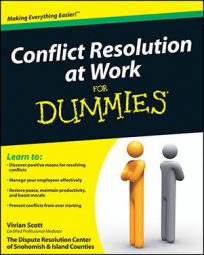The most important action you can take after resolving an employee conflict is simply to pay attention. This isn’t the time to assume that everything’s fine. Be alert for the positive and negative changes in the environment as you keep your finger on the pulse of the workplace.
You can monitor the situation without being obtrusive. Here’s how:
Keep your eyes and ears open. You don’t have to hold a drinking glass against the wall to catch your employees’ private conversations — you aren’t a spy, and you shouldn’t act like one. Instead, watch how your employees interact with each other and listen carefully to their language. If tension still exists, it’ll stand out — and that’s your cue that additional coaching or mediated conversations are necessary.
Look at the quantity and quality of work being done. One indication that previously feuding co-workers are back on track is an increase in the amount and value of work they now generate and a decrease in errors. As an employee becomes less distracted by conflict, you’ll notice a tangible improvement in his work because he’s more focused on the tasks at hand.
When you’re in a one-on-one situation with an employee, ask him how things are going. This question is a quick, unassuming one that opens the door for a more in-depth conversation. If he gives you a one-word answer, like, “Fine,” continue to ask open-ended questions such as, “I’m curious how you think the agreements are shaping up — can you tell me about that?” or “How do you think your colleague would describe your working relationship since the meeting?”
Check for a reduction in sick leave and absenteeism as your staff settles back into routines. If you notice that an employee is still calling in sick or missing in action, that’s a good indicator that he isn’t completely satisfied with the outcome of the meeting. Check in to see where the sticking points are and find out whether he’s willing to keep working on finding a solution. If not, you may need to consider corrective action.
If you have a system in place that allows employees to give feedback, check to see if any new information has come in. Address negative comments or lingering concerns either with the individual specifically or with the whole group. Make sure to handle the comment constructively by maintaining a positive outlook and working to solve the problem.
Rebuilding trust after a conflict takes time, so don’t be discouraged if you see some residual tension and frustration. Workplace mediations commonly take two to three sessions before everyone on the team is feeling better about the work atmosphere. Monitor the overall environment and step in when you can to maintain the progress that has been made. Be willing to come back together and fine-tune as needed.

